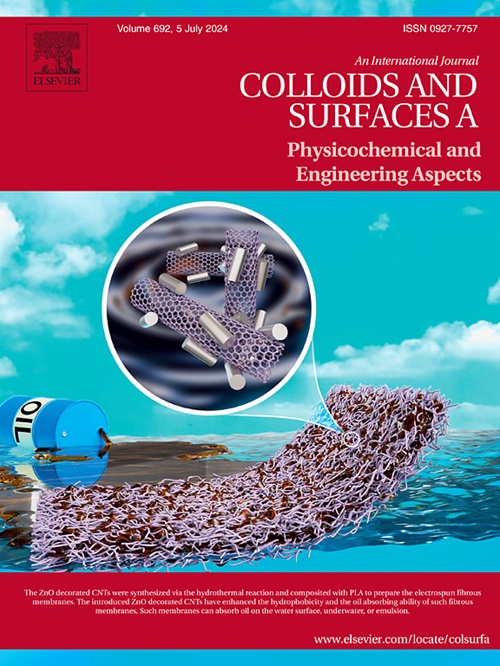Polyglyceryl-4 caprate and polyglycerol-3 provide low mobility and enhance ductility in Schizophyllum commune mycelium materials
IF 4.9
2区 化学
Q2 CHEMISTRY, PHYSICAL
Colloids and Surfaces A: Physicochemical and Engineering Aspects
Pub Date : 2025-04-27
DOI:10.1016/j.colsurfa.2025.137055
引用次数: 0
Abstract
Mycelium materials are an emerging class of bio-based fabrics. While the raw material typically exhibits poor elongation at break of 1–2 %, the addition of glycerol as a plasticizer can improve elongation at break up to 29.6 %. However, glycerol is prone to migration due to its small molecular size. This can cause it to move both within and outside the material, which negatively affects the mechanical properties of the material. To address this issue, films of Schizophyllum commune mycelium were treated with various plasticizers, including polyols, non-ionic and anionic surfactants, fatty acid esters, and polyether polyols. Among these, the biodegradable plasticizers polyglyceryl-4 caprate (PGFE-4) and polyglycerol-3 (PG-3) demonstrated the best results, either matching or surpassing glycerol in terms of elongation at break, while exhibiting less migration. The most notable improvements in elongation at break were observed with 4 % PGFE-4, 16 % PG-3, and 16 % glycerol, yielding values of 25.3 %, 24.9 %, and 17.7 %, respectively. Compared to glycerol, plasticizer migration was reduced by up to 11.5-fold with PGFE-4 and 1.8-fold with PG-3. In conclusion, PGFE-4 and PG-3 offer superior alternatives to glycerol, as they reduce migration, contributing to better material stability, and can enhance mechanical properties of the mycelium.
聚甘油-4己酸酯和聚甘油-3在裂叶植物菌丝材料中提供低流动性和增强延展性
菌丝材料是一类新兴的生物基织物。虽然原料的断裂伸长率通常为1-2 %,但添加甘油作为增塑剂可以提高断裂伸长率,最高可达29.6 %。然而,甘油由于其小分子尺寸,容易迁移。这可能会导致它在材料内外移动,从而对材料的机械性能产生负面影响。为了解决这一问题,用多种增塑剂,包括多元醇、非离子和阴离子表面活性剂、脂肪酸酯和聚醚多元醇,对裂藻菌丝体薄膜进行了处理。其中,可生物降解增塑剂聚甘油-4己酸酯(PGFE-4)和聚甘油-3 (PG-3)表现出最好的效果,在断裂伸长率方面与甘油相当或超过甘油,同时表现出较少的迁移。当添加4 % PGFE-4、16 % PG-3和16 %甘油时,断裂伸长率的提高最为显著,产率分别为25.3 %、24.9 %和17.7 %。与甘油相比,PGFE-4和PG-3的增塑剂迁移量分别减少了11.5倍和1.8倍。综上所述,PGFE-4和PG-3是甘油的更好替代品,因为它们减少了迁移,有助于更好的材料稳定性,并且可以提高菌丝体的机械性能。
本文章由计算机程序翻译,如有差异,请以英文原文为准。
求助全文
约1分钟内获得全文
求助全文
来源期刊
CiteScore
8.70
自引率
9.60%
发文量
2421
审稿时长
56 days
期刊介绍:
Colloids and Surfaces A: Physicochemical and Engineering Aspects is an international journal devoted to the science underlying applications of colloids and interfacial phenomena.
The journal aims at publishing high quality research papers featuring new materials or new insights into the role of colloid and interface science in (for example) food, energy, minerals processing, pharmaceuticals or the environment.

 求助内容:
求助内容: 应助结果提醒方式:
应助结果提醒方式:


